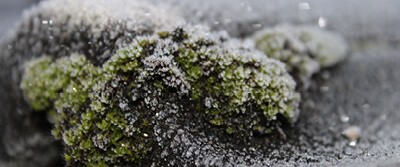Uncovering Moss and Its Story of Climate Change

By Christina Phillis
As the planet gets warmer, ice in areas like Canada’s Eastern Arctic is melting, uncovering moss that hasn’t seen the light of day for tens of thousands of years. For scientists tracking the progress of climate change, these plants are helping them paint a more accurate picture. The moss collected so far has been determined to be from 45,000 to 115,000 years old, indicating that the summertime temperatures in this region are the warmest that they’ve been for quite some time.
“It truly is an indication that humans are pushing the climate into a new regime,” said Lee Corbett, a geologist at the University of Vermont in Burlington.
How old is old?
To track the growth and retreat of ice on Baffin Island in Northern Canada, Gifford Miller of the University of Colorado Boulder and his team needed to determine the age of the moss being uncovered at the very edges of the ice. Using a technique called radiocarbon dating, they examined the carbon in the mosses to see when they last were exposed to the atmosphere and used sunlight to perform photosynthesis.
Radiocarbon dating is performed by comparing the ratio of radioactive carbon (carbon-14) to the amount of nonradioactive carbon (carbon-12) in a sample. As the carbon-14 decays, this ratio changes. The half-life of carbon-14 is about 5,730 years; over that time, half of the carbon-14 atoms in a sample will have decayed into a nonradioactive nitrogen isotope. This technique works only for samples less than 45,000 to 50,000 years old, since most of an object’s radiocarbon will have decayed by then.
Of the 370 different plant samples that Miller’s team collected on Baffin Island, there were three different groups of mosses with distinct ages: 3,700, 900, and 567 years old. Some plants were too old for radiocarbon dating, so the researchers looked at an ice core found in nearby Greenland. The results suggested that the planet experienced continuous cold during the period from 40,000 to 115,000 years ago.
Miller and his team never thought they’d find moss that was 3,700 years old, and certainly didn’t expect to see 45,000-year-old moss. He said this proves that it’s only a matter of time before increased summer temperatures melt all of the ice in the eastern Canadian Arctic. This changing landscape is yet another result of climate change.
Discussion Questions
- How does melting ice in a region affect the people, animals and plants living there?
- What are some of the other side effects of rising temperatures?
Vocabulary
- Radiocarbon dating
- Half-life
- Photosynthesis
- Radioactive
- Isotope